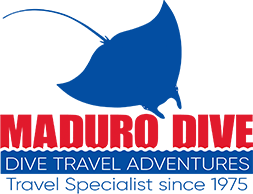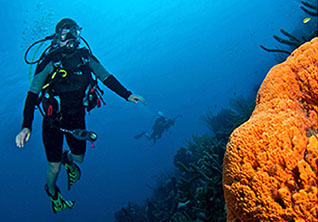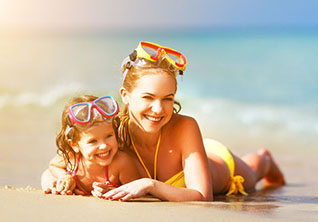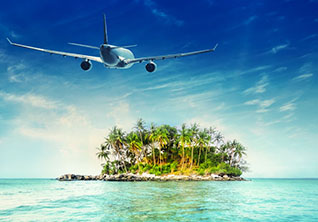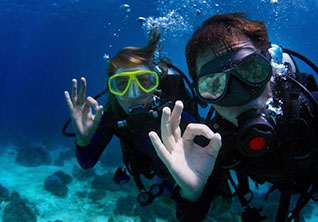Dominica The Nature Island
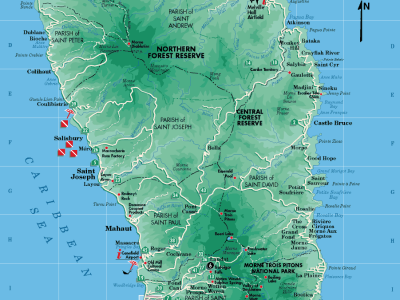
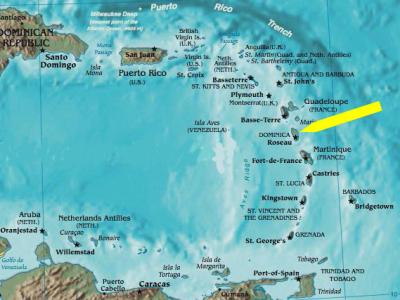
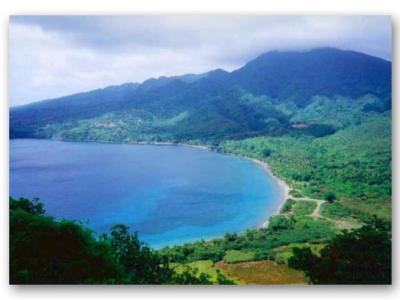
If you immediately think this island is adjacent to Haiti and next to Puerto Rico, this is not the island you’re looking for. Dominica “the Nature Island” can only be found by traveling over to the Lesser Antilles in the Caribbean Sea and there between Guadelupe and Martinique close to half a dozen volcanoes rose up from the deep sea floor and separated the Caribbean from the Atlantic ocean by forming one of the youngest islands in the Lesser Antilles: approximately 290 sqmi (750 km squared). Three of these volcano peaks rose above 4,000ft (1220m) in height. Morne Diablotin (Diablotin Mountain), the highest, stands at over 4,692ft (1430m) tall and has been inactive since the Holocene epoch or last 10,000 years. Morne Trois Pitons erupted a mere 920 years ago. These tall mountains collect moisture from passing clouds and disperse this mist over the island in the form of rain, streams, and rivers, making Dominica one of the most prolific and relatively untouched rainforests in the Caribbean. There are many rare plants and birds on the island. In fact, the Sisserou Parrot (Imperial Amazon) is only found on this island and on Dominica’s flag as well.
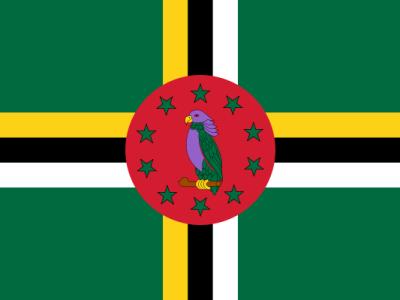
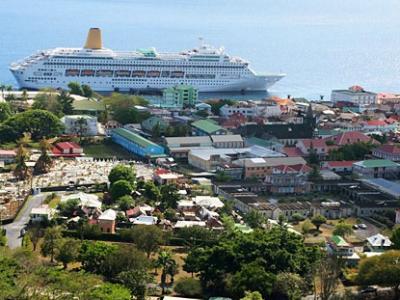
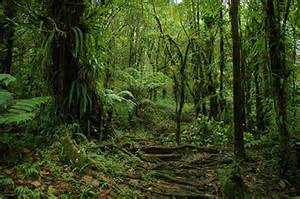
By the way, Dominica is pronounced with the stress on the second “i” as in DOM-i-NEE-ka. We think that the stress on the island name Domin”í”ca will perhaps be the only stressful event you encounter when visiting the island.
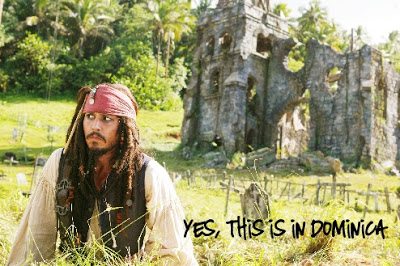
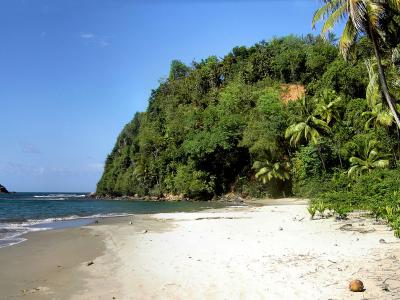
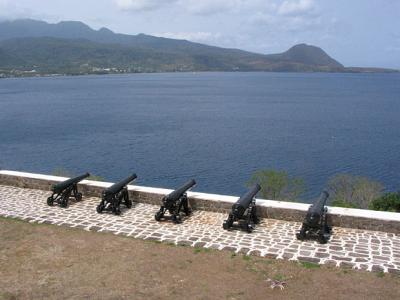
One last note on the natural pristine beauty of this island is the fact that both Pirates of the Caribbean movies two and three were filmed here because, even Hollywood can’t make a background as cool as the naturally occurring settings on the beaches and along the Indian River.
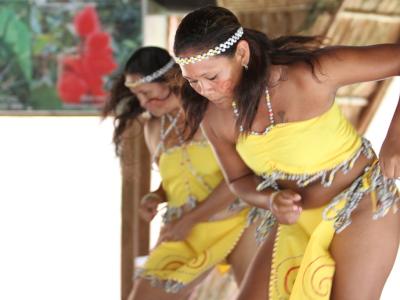
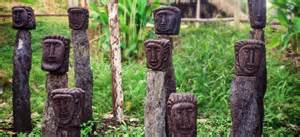
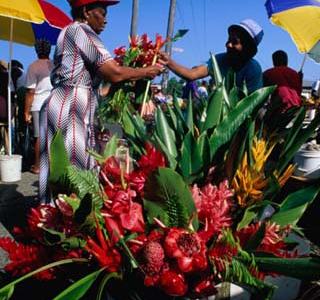
As far as the historical background goes, Columbus discovered the island on Sunday November 3rd, 1493 during his second voyage and therefore named it Dominica which in Latin (dies dominica) apparently means “Professional Sport’s Day” (our Latin may be a little rusty). Fortunately he didn’t discover more islands on Sundays or there would be more confusion on which island was which, than there already is. The Spanish never did much with the island and that upmost remarkably includes not slaughtering or dislocating every member of the local population of Island Caribs or Kalinago, as happened on most other Caribbean Islands. Even to this day on the northern end of the island there is a reservation similar to U.S. and Canada for indigenous islanders. Next came the French who in 1727 harvested timber and set up coffee plantations with the help of enslaved West Africans. The West Africans quickly made up the majority of the Island’s population and a dialect of French Antillean Creole became the dominant language. In 1761 the English invaded and ever since then, English has been the official language. There were more fights and squabbles between the French and English, but this is the quick cliff note version for scuba divers who prefer their history not too dry.
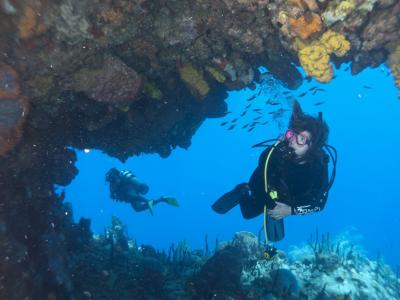
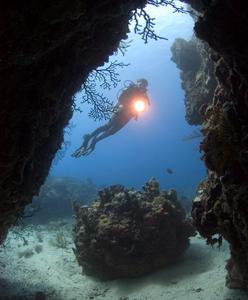
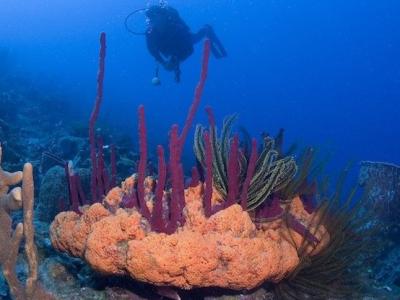
As for divers, the young volcanic nature of the island lends to black sand beaches, swim throughs, crevices, tunnels, corals growing on granites, deep walls, canyons, finger like ridges, and unique warms spots where volcanically heated water is swept up between fissures and cracks and in one location is known for the sulfur tinted bubbles that rise towards the surface in what appears to be an endless procession.
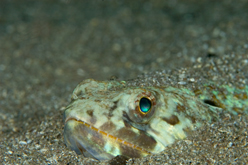
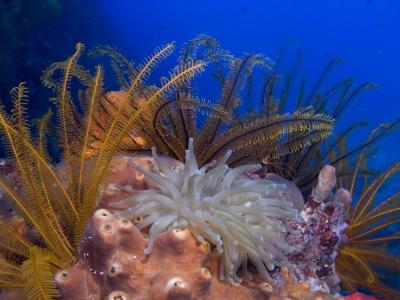
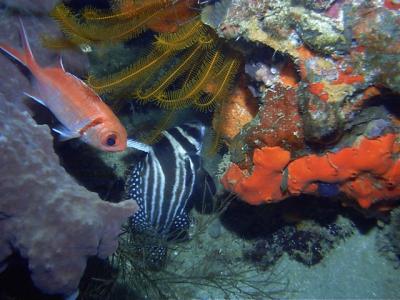
As for the fish and invertebrates, this secluded island boasts vast schools of jacks, grunts, big eyes, flying gurnards, squirrelfish, frogfish, angle fish, blue chromis, seahorses, eagle rays, spotted rays, southern sting rays, turtles, tube sponges, a wide variety of soft and hard corals, octopus, lobster, crabs, and flamingo tongue shells to name a few.
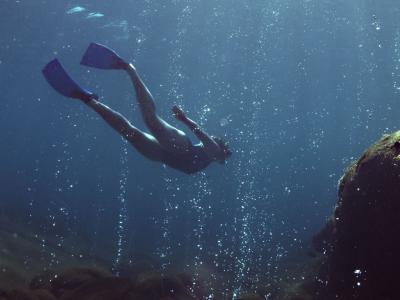
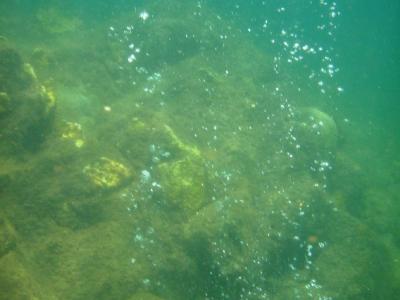
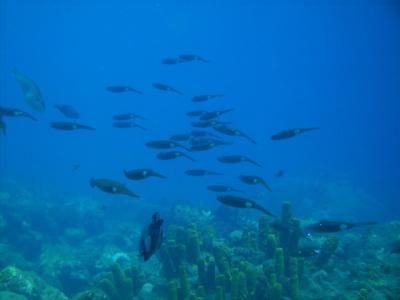
As for the dive sites, the unique volcanic past has created some one of a kind dive spots at the south end of the island. The Scottshead Soufriere Marine Reserve encompasses three miles of coastline and a large submerged crater. One of the most famous dive and snorkel destinations is in the most northern area of the marine reserve and is called Champagne Reef. The entrance is from shore via a long wooded walkway to help avoid the long rock strewn beach. Divers typically do a leisurely swim around the fish and corals and perhaps take in a view of a prevalent school of reef squid. Then at around 15ft (5m) while relaxing at a deco stop you can view what appears to be champagne bubbles seeping out from the sand and up between the rocks. This hot water and bubbles can burn your hand if you place it too close to the sub-aquatic hot springs, but the scene is a mesmerizing sight to witness. The repeatedly requested dive site Swiss Cheese with three swim throughs and two large granite rocks that form an arch way that leads to a coral area and across to a famous spot called Scottshead Pinnacle with a swim through at 35ft (11m) that exits to a wall that drops down to 120ft (37m) should not be missed. Another popular spot is Dangleben’s Pinnacle which is a series of five swim throughs that you can circumnavigate down at 80ft (25m) and the area is filled with colorful vertebrates and invertebrates alike. Also well known here is L’Abym with a wall that descends straight down to 1500ft (457m).
In the middle of the island on the west side we have well known dive sites such as sloping Nose Reef, and Rina’s Hole with a swim through, black coral, azure vase sponges, golden crinoids, and if you see a thing in the reef with bright shinny teeth, that’s a moray. Actually, here there are several moray eels. Rodney’s Rock is considered one of the best critter dives around and a good spot to find assorted crabs and spiny as well as slipper lobsters.
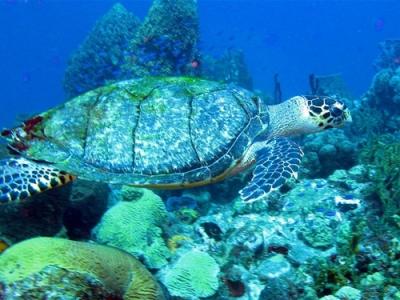
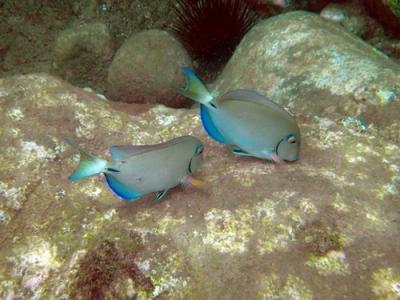
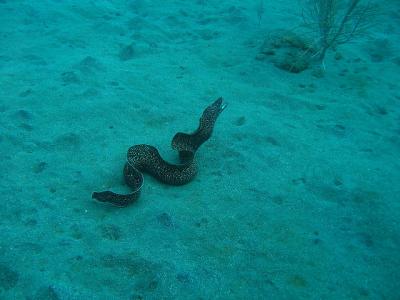
Up by Portsmouth, Cabrits Dive Site is a great drift dive over barrel sponges and schools of creole accented fish. Douglas Point is known for its abundance of flamingo tongue shells, Pointe Ronde and the Craters has hot bubbles percolating out of the sand at 120ft (37m), Toucari Bay has coral covered rocks at 40ft (12m), two tunnels plus multiple caves, and Five Finger Rock in the Cabrit Marine Park appears mostly submerged in the shape of its name sake with lots of critter life as well.
For wreck divers, there is the 55ft long (17m) Canefield Tug Wreck sitting almost perfectly upright at 90ft (27.5m) and the links of chain from the 18th century Cottage Point Wreck in less than 30ft (9m) has some interesting pinnacles close by..
As for night dives, there is Newtown Dropoff, Sea World Pinnacle, Fort Young Flats, or a second round at Rodney’s Rock.
There are over thirty official dive sites around the island, as well as “secret spots” which can be experienced when weather and currents permit exploring.
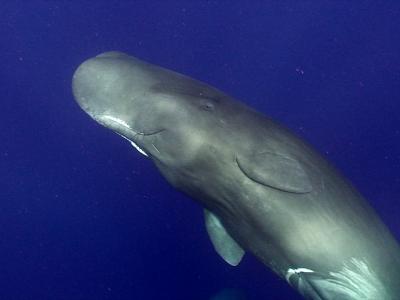
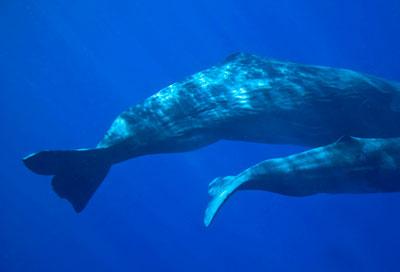
For a non-diving day, you still will want to remain on the water as whales are prevalent throughout the year. Whale watching tours go out to see, hear, and record the sounds of sperm whales; the largest toothed whales in the world who can be seen from October to March. The nomadic males get up to 60ft long (18m) and don’t socialize until they are 30 years old. Females form natal family units that encompass several generations and may consist of 70 year old grandmothers, mothers, and male and female calves that enjoy the gentle deep waters off the west coast of Dominica. The waters offshore dip down to over 3,280ft (1,000m) and this is where sperm whales are presumed to hunt for giant squid using their spermaceti organ in their oversized nose region as a sonar system in the deep dark waters to locate their prey. They also make social noises “codas” with different clicks, sounds, and dialects around the world. Using a boat’s hydrophone you can hear these sounds miles or kilometers away. For an extra treat, Humpback whales can be heard in January and February. We like to think of these boat trips as the beginning of Eco “Echolocation” Tourism. There are some twenty other mammal species that frequent the islands including: spotted and spinner dolphins that roam in mixed pods of over 500 members strong, pilot whales in pods of 50 members, and bottle nose, risso’s, and other dolphins in smaller groups.
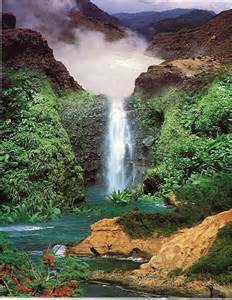
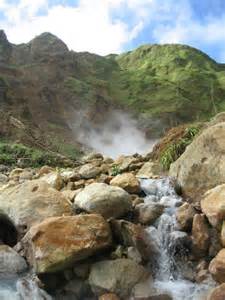
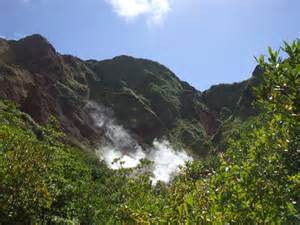
Now if you would like some time off from getting wet, then we recommend hiking some 300 miles (500km) around the island and visiting Trafalgar Falls, Victoria Falls, and Emerald Pool. We recommend taking a poncho and sweater with you as it can get cold, and the rain falls over five times as much up in the mountains as it does near the beaches. Hiking in the Morne Trois Pitons National Park rainforest is a must to see Boiling Lake; the second largest boiling lake in the world. On the way up to this site, tourists often stop in the Valley of Desolation to boil an egg in the sulfur laden springs or creek. Personally, we prefer eggs at a table setting with a pinch of salt, sometime before the eight mile (130km) return hike begins. You also have the chance to rest in relaxing hot springs along many trails, so in Dominica you never really have to miss being out of water any day during your entire stay; it’s your choice.
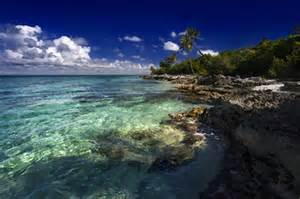
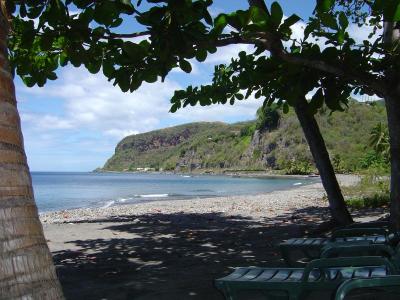
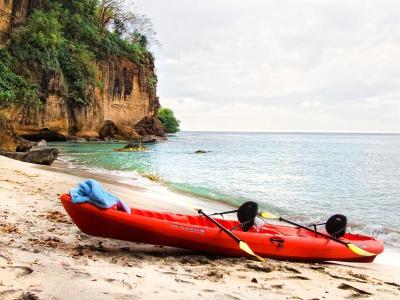
There is much here for all to discover as Dominica is a remote volcanically formed island lush with tropical rainforests, rivers, waterfalls, friendly people and abundant sea life. You have to change planes from one of the nearby Caribbean islands to reach one of the two local Dominica regional airports, and you also have to stress the way you say the island name, but coming here is definitely worth the effort to have a chance to explore what is rightly called the nature island, and dive literally some of the hottest dive sites on this planet.
For additional information on Dominica and various special dive and vacation packages, Click here.
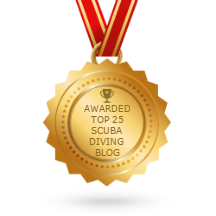
Recent Posts
- Eastern Malaysia, Sabah, Sipadan & More
- Ghost Pipefish, Pipefish, Seahorses, and Sea Dragons
- Australia Queensland and the Great Barrier Reef
- Tioman Islands, Malaysia
- The Riviera Maya
- The Peter Diving System
- The Bay Islands, Roatan, Utila, Guanaja, and more.
- The Cuttlefish; The Undisputed Master of Camouflage.
- The Maldives: A Garland of Islands in the Indian Ocean
- Frogfish, The Overlooked Camouflage Artist
Categories
- Australia
- Bahamas
- Bay Islands
- Belize
- Blue Hole
- Bonaire Diving
- Borneo
- Cayman Brac
- Cayman Islands
- Cozumel
- Curacao
- Cuttlefish
- Dive Destinations
- Dive Equipment
- Dive Liveaboards
- Dive Resorts / Properties
- Dive Travel
- Dive Travel Deals
- Diver Wellness
- Dolphins
- Dominica
- Eagle Rays
- eagle rays
- Family Travel
- Fiji
- Galapagos Islands
- Great White Shark cage diving
- Guanaja
- Honduras
- Indonesia
- Infographics
- Isla Mujeres
- Learning to Dive
- Little Cayman
- Maduro Dive Newsletter
- Malaysia
- Maldives
- Manta Rays
- Marine Life
- Mexico
- Micronesia
- Muck Diving
- Myamar
- Palau
- Papua New Guinea
- Pelagics
- Philippines
- Pinnacles
- Polynesia
- Reefs
- Riviera Maya
- Roatan
- Saba
- Sabah
- Scuba Diving
- Scuba Gear Reviews
- Scuba News/Events
- Scuba Training & Education
- Sea Legends
- sea lions
- Sea of Cortez
- Sharks
- Single Travel
- Sipadan
- Socorro Islands
- South Africa
- Specialties
- ST. Kitts
- Stingrays
- Tahiti
- Thailand
- The Bucket List
- Tobago
- Truk Lagoon (Chuuk)
- Turks and Caicos Islands
- Turtles
- Uncategorized
- Underwater Photography
- Underwater Video
- Utila
- Walls
- Whale Sharks
- Whales
- Wreck Diving
- Wrecks
- Yap
Archives
- January 2024
- April 2023
- March 2020
- March 2019
- January 2019
- November 2018
- September 2018
- July 2018
- May 2018
- March 2018
- January 2018
- October 2017
- September 2017
- June 2017
- April 2017
- February 2017
- January 2017
- October 2016
- August 2016
- July 2016
- May 2016
- March 2016
- February 2016
- January 2016
- December 2015
- August 2015
- June 2015
- April 2015
- January 2015
- November 2014
- July 2014
- April 2014
- February 2014
- December 2013
- November 2013
- October 2013
- September 2013
- August 2013
- July 2013
- June 2013
- May 2013
- April 2013
- March 2013
- February 2013
- January 2013
- December 2012
- November 2012
- October 2012
- September 2012
- August 2012
- July 2012
- June 2012
- May 2012
- April 2012
